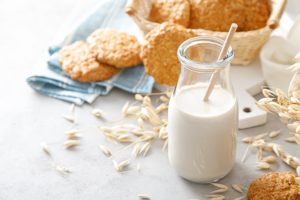Every meal is incomplete without a dessert. It’s a universal phenomenon. Bonus points if it is cold. The first recorded ancestor of an ice cream-like dessert originated in Ancient China. To be more specific, the Tang Dynasty, in 618 AD. Frozen desserts have evolved and taken in all shapes, formats and colours. Frozen desserts steal hearts everywhere, from gelatos in Italy to kulfis in India, from dondurmas in Turkey to sundaes in America. So much so that, TasteAtlas has listed 90 of the world’s favourite frozen desserts. Needless to say, there are far more frozen desserts that the world is yet to know.
In case you didn’t notice, we have only spoken about frozen desserts. So does this mean we are talking about ice creams as well? Wait, don’t the terms “frozen desserts” and “ice creams” mean the same thing? Actually, no. The terms “frozen dessert” and “ice cream” are often used interchangeably, leading to widespread confusion. While both offer refreshing indulgence, they are distinct products with unique characteristics. Exploring ice cream trends can help highlight the latest innovations in both categories.Let’s delve deeper into the world of frozen treats to uncover the key differences.
What is Ice-Cream?
Ice cream, a beloved classic, is a frozen food dessert primarily crafted from dairy products, such as milk and cream. The defining characteristic of ice cream is its minimum 10% milk fat content, which contributes to its rich, creamy texture. Often, natural color in ice cream is used to enhance its visual appeal, maintaining a healthier alternative to artificial dyes. The process involves churning a sweetened mixture of cream, milk, and flavors while freezing, incorporating air to create a light and airy consistency. This combination of ingredients and process results in the iconic ice cream experience.
From the classic vanilla and chocolate to the plethora of flavours, ice cream has captivated taste buds for generations. The versatility of ice cream is further enhanced by the varieties of add-ons like fruits, nuts, candies, and cookies, offering a customizable treat for every palate.
What is a Frozen Dessert?
A frozen dessert encompasses a broader spectrum of chilled treats that extend beyond the confines of dairy-based products. This category includes a diverse range of options, from fruit-based sorbets to creamy non-dairy alternatives. The common denominator among frozen desserts is their frozen state, achieved through various combinations of ingredients.
Unlike ice cream, frozen desserts can be crafted with a wide array of components, including fruits, water, sugar, and dairy or plant-based alternatives. This flexibility allows for an expansive range of flavours, textures, and nutritional profiles. Whether you seek the refreshing tanginess of sorbet or the creamy indulgence of non-dairy ice cream, the world of frozen desserts offers something to satisfy every craving.

Difference Between Ice-cream and Frozen Dessert
Texture and Taste
The most apparent difference lies in their texture and taste. Ice cream’s higher milk fat content results in a rich, creamy, and smooth mouthfeel. In contrast, frozen desserts exhibit a wider range of textures, from the icy and refreshing sorbet to the tangy and slightly tart frozen yoghurt.
Flavour Profiles
Ice cream, traditionally dairy-based, offers a vast array of flavours. However, frozen desserts boast an even more extensive flavour palette. Fruit-forward sorbets capture the essence of the fruit, while non-dairy ice creams cater to those with dietary restrictions, providing delicious alternatives to traditional ice cream.
Nutritional Differences
Ice cream, a good source of calcium and protein, is also higher in fat and calories due to its dairy base. Frozen desserts, particularly fruit-based options and those made with low-fat ingredients, can be a healthier choice. However, it’s crucial to read labels as some frozen desserts may contain added sugars and artificial ingredients, while others might use natural food colour to maintain a healthier profile without compromising on appearance or flavor.
Dietary Preferences and Restrictions
For individuals with lactose intolerance or dairy allergies, frozen desserts offer a delightful and inclusive alternative. Non-dairy ice creams, sorbet, and sherbet provide delicious options without compromising on taste. Ice cream, unfortunately, is off-limits for those with dairy sensitivities.
Popularity and Availability
Ice cream, a timeless treat, enjoys widespread popularity and availability. Frozen desserts, while gaining traction, still have a smaller market share. Nevertheless, the growing demand for healthier and plant-based options is driving the expansion of the frozen dessert category.
Read more here.
Frozen Desserts: A Cultural Mirror
Frozen desserts are more than just a way to cool down; they reflect cultural identity, history, and social practices. They bring people together, celebrate heritage, and offer a sweet taste of tradition. Here are a few examples:
Italy: Gelato is not just a treat but a cultural icon. The Gelato Festival, held annually, celebrates this beloved dessert with competitions, tastings, and workshops, highlighting its importance in Italian culture.
India: Kulfi is a staple at many Indian festivals and weddings. Its rich, creamy texture and traditional flavours like cardamom and saffron make it a festive favourite.
Japan: Mochi ice cream is often enjoyed during New Year’s celebrations and other festivals.
United States: Ice cream parlours and soda fountains have long been social hubs where people gather to enjoy sundaes, milkshakes, and cones.
Turkey: Dondurma vendors serve the unique stretchy ice cream with a playful performance, adding to the communal experience.
China: In ancient China, frozen desserts made from snow and fruit juices were enjoyed by royalty and used in rituals to symbolize purity and luxury.
Mexico: Paletas, or Mexican ice pops, are a symbol of Mexican ingenuity and the use of local fruits and flavours.
Thailand: Thai rolled ice cream, made by pouring a liquid base onto a cold plate and rolling it into spirals, showcases the creativity and street food culture of Thailand.
Conclusion
Ice cream and frozen desserts are distinct products with different characteristics. Ice cream, a dairy-based treat, has a higher milk fat content, resulting in a rich, creamy texture. Frozen desserts, a broader category, can vary widely in composition and may use ingredients like fruit or plant-based alternatives. Often, frozen desserts rely on innovative ingredient solutions to achieve desired textures and flavors. To differentiate between the two, check labels and consider taste and texture. Ice cream is typically richer, while frozen desserts can be lighter and more refreshing.
Frequently Asked Questions
Ice cream must contain at least 10% butterfat, while frozen dessert has more flexible ingredient requirements.
Both can vary in healthiness depending on the ingredients. Factors like calorie count, sugar, and added fats matter.
Yes, with an ice cream maker. You can customise flavours and ingredients.
Store both below 0°F. Ice cream generally lasts longer due to its higher fat content.
Vanilla, chocolate, and strawberry are classic choices.
Frozen yoghurt, sorbet, kulfi and gelato offer different tastes and textures.




